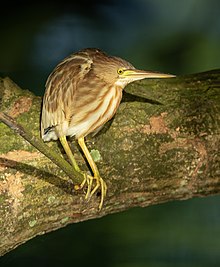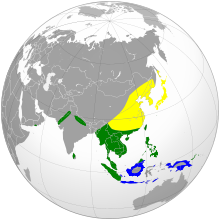|
Yellow bittern
The yellow bittern (Botaurus sinensis) is a small bittern. It is of Old World origins, breeding in the northern Indian Subcontinent, east to the Russian Far East, Japan and Indonesia. It is mainly resident, but some northern birds migrate short distances. It has been recorded as a vagrant in Alaska and there is a single sighting in Great Britain, from Radipole Lake, Dorset on November 23, 1962 – however, the British Ornithologists' Union has always considered this occurrence to be of uncertain provenance and currently it is not accepted onto the official British List. This species was formerly placed in the genus Ixobrychus. TaxonomyThe yellow bittern was formally described in 1789 by Johann Friedrich Gmelin in his revised and expanded edition of Systema Naturae. He placed it with the herons, cranes, storks and bitterns in the genus Ardea and coined the binomial name Ardea sinensis.[2] Gmelin based his description on the "Chinese heron" that had been included by the English ornithologist John Latham in his multi-volume work A General Synopsis of Birds. Latham based his description on a collection of Chinese drawings.[3] The yellow bittern was formerly placed in the genus Ixobrychus. A molecular phylogenetic study of the heron family Ardeidae published in 2023 found that Ixobrychus was paraphyletic and to create monophyletic genera, Ixobrychus was merged into the genus Botaurus that had been introduced in 1819 by the English naturalist James Francis Stephens.[4][5][6] The genus name Botaurus is Medieval Latin for a bittern. The specific epithet sinensis is Modern Latin meaning "China".[7] The species is monotypic: no subspecies are recognised.[5] DescriptionThe yellow bittern is a small species at 36 to 38 cm (14 to 15 in) in length, with a short neck and longish bill.[8][9] It has yellow green legs, an ivory bill (darker on top), a short black tail and yellow irises.[10][11] The male of the species has a dark cap, chestnut head and neck, with a uniformly dull yellow body above and buff below.[9][12] The female's cap, neck and breast are streaked, with a rufous hindneck and upper back and streaked dark red brown and buff under parts.[10] The juveniles of the species resemble the female but is more boldly streaked, brown on its head and back, and mottled with buff above.[9][10][13] Distribution and habitat Yellow bittern's are found in fresh water marshes and swamps.[10] It nests in small constructed platforms of reeds or twigs in the vegetation of reed beds or in trees and shrubs adjacent to or above water.[10][12][14] They lay four to six pale blue-green eggs.[14][15] Behaviour and ecologyYellow bitterns feed on a variety of insects, fish, amphibians, crustaceans and molluscs.[15] ConservationThe yellow bittern is protected under the Migratory Bird Treaty Act of 1918.[16][17] Gallery
References
|
||||||||||||||||||||||||||||||||||||





